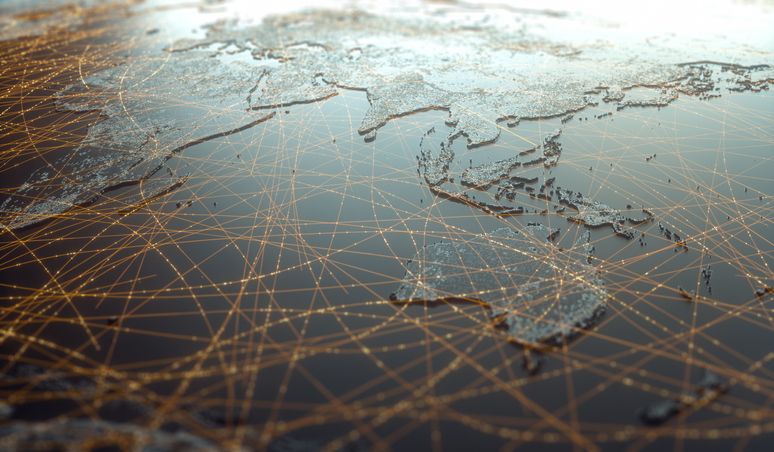The global pandemic has changed our view of the world forever
This may be particularly true in terms of how we work, play, shop and travel. Our new mindset may mean that we work from home more frequently, use online shopping for more of our needs, stream more movies, and continue feeding our heightened interest in online video gaming.
Companies, too, have a different mindset and are behaving differently, as a result. Certainly, they’re protecting their balance sheets – and rightly so, if they expect to be profitable in years to come. But companies of all sizes are also starting to ensure their supply chains are stable and more resilient to shocks. The reason is obvious: Covid-19 has delivered a first-hand experience of the catastrophic disruption that a global pandemic can bring.
So, faced with the threat of such disastrous results, companies are asking themselves: What else could cause this much disruption? What other events should we be prepared for? The answer, save a second wave of the health crisis, is unarguably climate change.
While climate change will not have the same immediate brutality that the pandemic (and ensuing lockdown) has had, its impacts will be long lasting and every bit as biting. Over the next few decades, extreme heat, high sea levels, and drought could ravage almost one-third of the world’s population, causing mass migration, food shortages, and an alarming drop in education and health services – all factors which will inevitably lead to supply chain failures. Exacerbating the situation is that the impacts of climate change will be worse for the developed world’s supply chains: Southeast Asia, India, South America and the Middle East.
Some companies are unprepared for another round of supply chain shock. The financial boom of the past decade has permitted companies not focused on supply chain issues to ignore potential threats of global warming or similar overwhelming environmental shocks that could come in the not-too-distant future. A few groups have lumped their eggs in one basket, depending too heavily on specific suppliers or on single locations to keep their businesses alive. Armed with the experience of a pandemic and facing the implications of climate change, some are now re-evaluating their supply chain strategies.
Diversify
One solution is diversification; sourcing various goods and services from strategically different suppliers. Companies that build multiple bases of operation and have more localised supply chains to service their sites experience a smoother transition of workflow between locations. AstraZeneca, the UK based pharmaceutical group, operates in over 100 different countries providing medicines and therapies for oncological and respiratory problems. During the pandemic, the pharma giant was able to leverage its global presence to shift the geographical focus of some of its trials to areas less affected by Covid-19.
Some clothing and home goods retailers are using clothing and food suppliers based in Europe to reduce their reliance on suppliers in regions with potentially higher climate change exposure. Marks & Spencer’s clothing and food originate from an array of suppliers located across Asia, Europe and North America, providing a high degree of diversification across product and geographical location. This diversification also helps the group to provide quickly the items that are popular with customers.
Diversification obviously comes at a cost and can introduce new risks, such as a myriad of regional legislative restrictions. Having multiple suppliers could also substantially lower the quality of the end-product and create unmanageable oversight issues for a company. But done prudently, diversifying a supply chain can add real value and mitigate unnecessary over exposure to any one supplier which, in unforeseen circumstances, can leave a company holding an empty basket.
Simplify and localise
Companies can also streamline their supply chains to extract maximum efficiency while simultaneously reducing carbon emissions. Electrocomponents, the British distributor of industrial and electrical products, is using more regional suppliers for its operations in Asia, Europe and in the US to build tailored components for customers. This change means the group wastes less time and energy transporting products across longer distances, particularly in Asia and the US. It also helps reduce the group’s carbon emissions through smarter logistics.
There is also rising value in having localised supply chains that companies can control and oversee themselves. Populism, which has influenced a return to tribalism around the world, has helped stoke some fear in having dependency on supply chains that are far away, under threat of being taken over by other groups, or simply not functioning. Mercadolibre, the Latin American e-commerce and payments group, for example, has been investing substantially in its supply chain for the last few years, following its heavy over-dependence on the regional post office to deliver goods on time. The “Correios”, who would typically go on strike or were slow in delivering packages, left the retailer no choice but to build its own supply chain in the shape of fulfilment centres, warehouses, and cross docking stations. Beneficially for the group, Mercadolibre managed to vertically integrate in a way that wasn’t overly capital intensive. The results were not only an improvement in customer satisfaction and more timely deliveries, but also reduced costs and improved margins for the company as a whole.
Incentivise
Companies are incentivising home delivery and supply chain workers to ensure customer demand is met even as demand exploded during lockdown. Amazon, for example, whose sales were better than expected in Q1, undertook an enormous hiring spree to help get critical products to quarantined customers. Amazon, realising the value of its supply chain and delivery workforce, raised the hourly wage by $2 – a wage hike, which combined with expenses to help protect its workforce from the virus, could cost the group around $4bn(1).
Pizza restaurant chain, Dominos, has also benefitted from increased demand during quarantine. The group has provided higher bonuses to staff, including those with home delivery roles, in an effort to provide a quality service to customers and keep employees on side.
Automate
The food industry has been particularly hard hit by the shock of the pandemic, as its supply chain workers have sometimes either succumbed to Covid-19 or been too afraid to return to their jobs. The sector already has its share of problems, as groups like Tyson Foods, the world’s second largest meat processor, whose workforce consists largely of immigrants and minorities, are plagued by allegations that they suppress worker pay and demand workers operate in cramped environments for long hours each day(2). Meat processors, food retail warehouse workers, employees that stock grocery shelves, farm workers – all have been impacted by the pandemic, leaving the food industry struggling to feed millions of people when their supply chains are sorely understaffed.
Robotics (software and hardware) is a growing solution to understaffed supply chains. Helping with the most menial tasks like cleaning floors, moving goods in warehouses, picking items and packing boxes, robots can help improve efficiency and reduce the danger of spreading disease. They can also help fill orders while simultaneously keeping track of inventory levels. For the food industry, this could be critical.
For example, around 20% of all field labourers in southern California come from Mexico, but with the borders closed due to the pandemic, farmers are scrambling for help(3). AI in robots or in automated guided vehicles enables them to do the jobs that, no matter how mundane, previously were too intricate to do by robots, like picking fruit, weeding, stacking boxes, and disinfecting floors. For years, Amazon has had the lead in warehouse automation after it acquired Kiva Systems (now called Amazon Robotics) in 2012. But others, like Walmart and CVS, are starting to catch up, as they aim to protect their supply chains from future external shocks and crippling disruptions.
Organise
Many companies are also looking at ways to improve their own warehouse management. Grocery store chains, like Tesco, have worked for years to facilitate the transportation of food and home goods from their warehouses to their super stores and local outlets with optimum efficiency. During the pandemic, food warehousing went into overdrive, as consumers stock-piled for an unknown amount of time indoors. Optimised logistics helped food retailers keep on top of the storage and distribution of goods. Associated British Foods, owner of clothing retailer Primark, also used the time during quarantine to check on warehouses and make longer-term decisions about its inventory. The retailer, which does not currently offer an e-commerce platform, has made every effort not to destroy inventory due to its retail shops being closed. Instead, the group is using consumer data to help determine better logistics and warehouse management to minimise wastage and know what to purchase from its clothing manufacturers over the next few months.
Prepare
Companies face a real and immediate need to make their supply chains more resilient to global shocks, one of which will inevitably be global warming. Any changes that companies make may also provide an opportunity to reduce carbon emissions in the production and transportation of goods, helping to make the entire supply chain more efficient and affordable. The actions that companies take now are critical to ensuring the health of their supply chains which, in turn, will impact the longevity of their businesses, overall.








